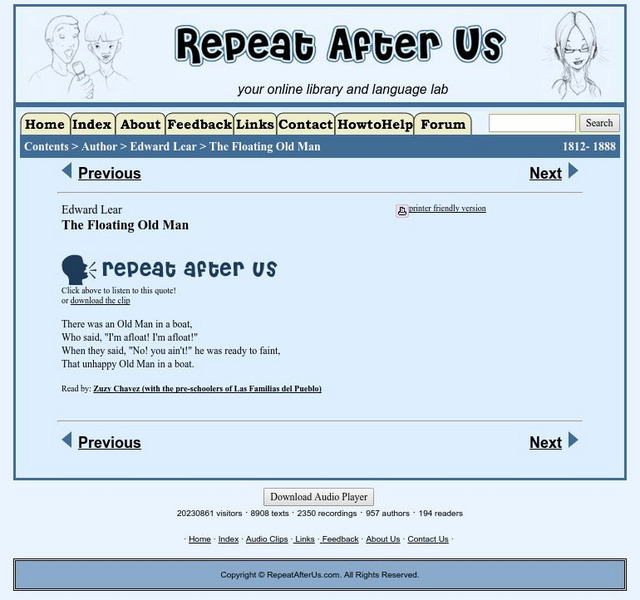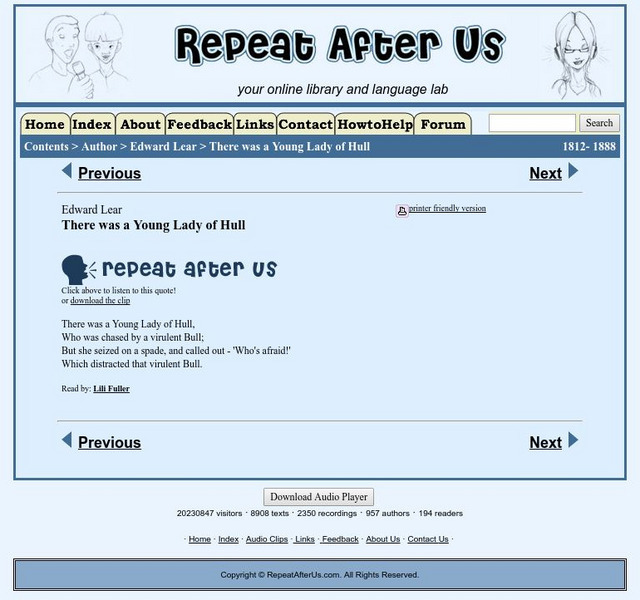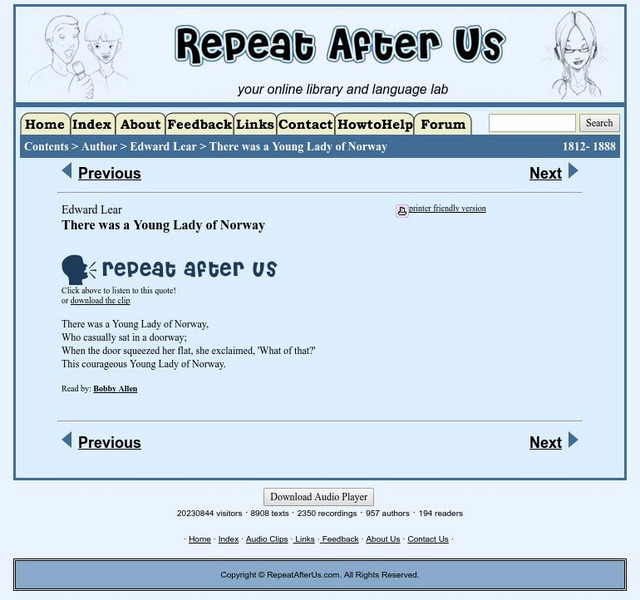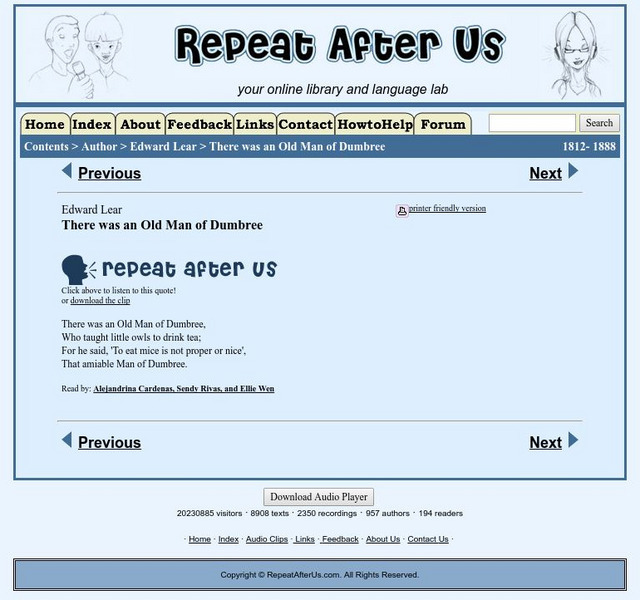Hi, what do you want to do?
Curated OER
Edward Lear, Limericks, and Nonsense
Introduce your class to the delights of nonsense poetry and explore literary devices with the writing of Edward Lear. Learners identify rhyme and meter as well as figures of speech, alliteration, and onomatopoeia in "The Owl and the...
Curated OER
Edward Lear, Limericks, and Nonsense: There Once Was?
Learners explore limericks. In this poetry writing lesson, students listen to and read a variety of poems written by Edward Lear. Learners count syllables and identify meter by clapping as they read aloud. Students complete a limerick...
Curated OER
Edward Lear, Limericks, and Nonsense: There Once Was...
Students recognize poetic devices including rhyme, syllabification, and meter. They identify the characteristics of a nonsense poem and of a limerick. They write their own limericks.
Poetry Society
The Jumblies
Who would ever think to go to sea in a sieve? Only Edward Lear's Jumblies! The poem "The Jumblies" is the inspiration for these poetry reading and writing activities that ask learners to think about how strangers are different, consider...
DLTK
Writing Limericks
Scholars are lucky to stretch their poetry writing muscles with a instructional activity that challenges them to compose two limericks—one about a boy and the other about a dog.
Curated OER
Lesson Plan for "The Owl and the Pussycat" by Edward Lear
Students find rhyming words in poem, get information from the pictures, explain the elements of a poem, and extend the poem.
Curated OER
Poetry
Explore the semantics of poetry with this higher-level presentation. With examples from Dickinson, Frost, and Dr. Seuss, the slides clearly explain the details of poetic structure, license, and schemes. You could use this in a language...
Poetry Out Loud
The Tabloid Ballad
What do the theme song from Gilligan's Island, the nursery rhyme "The Owl and the Pussy-Cat," and the poem "The Shooting of Dan McGrew" all have in common? Why, they're ballads of course! Challenge your young balladeers to compose their...
Teacher's Corner
Limerick
Young poets try their hand at one of the most popular fixed poetry forms, the limerick. The eighth in a series of ten poetry writing exercises.
Poetry4kids
How to Write a Traditional “Mother Goose” Nursery Rhyme
There may be some little lambs, itsy bitsy spiders, and pumpkin eaters in your language arts class! An online poetry lesson takes learners through the steps of writing a nursery rhyme with easy-to-follow steps and explanatory examples.
Curated OER
The Tabloid Ballad
Students explore the poetic ballad. They examine the rhythm of a typical ballad and listen to recitations of sample ballads. They choose an article from a supermarket tabloid and write a comical ballad using rhythms and structures...
Curated OER
The Kite is Key
Students recognize the phoneme /k/. Through listening and matching activities, students discriminate the phoneme /k/ from other letters and phonemes. They associate the phoneme /k/ with its letter representation and identify the phoneme...
Curated OER
First Letter Changes
Students use the books of Eric Carle to change the first letter in a word to see a new word. In this phonics lesson plan, students change the beginning letters in poems and books.
Curated OER
Snakes Are Silly
Students identify the grapheme and phoneme for S. They practice writing the letter S and through listening activities, discriminate the phoneme /s/. They associate the phoneme /s/ with its letter representation and identify it in various...
Repeat After Us
Repeat After Us: "The Owl and the Pussycat" by Edward Lear
This site offers the text and audio of the poem "The Owl and the Pussycat" by Edward Lear. Great for students to practice reading poetry aloud at an appropriate rate and with expression.
Repeat After Us
Repeat After Us: "The Floating Old Man" by Edward Lear
This site offers the text and audio of the limerick "The Floating Old Man" by Edward Lear. You can listen to the poem online or download it.
Repeat After Us
Repeat After Us: "The Jumblies" by Edward Lear
[To hear audio, use Chrome browser.] This site offers the text and audio of the poem "The Jumblies" by Edward Lear.
Repeat After Us
Repeat After Us: "There Was a Young Girl of Majorca" by Edward Lear
[To hear audio, use Chrome browser.] This site provides the text and audio of the poem "There Was a Young Girl of Majorca" by Edward Lear.
Repeat After Us
Repeat After Us: "There Was a Young Lady of Hull" by Edward Lear
[To hear audio, use Chrome browser.] This site offers the text and audio of the poem "There Was a Young Lady of Hull" by Edward Lear.
Repeat After Us
Repeat After Us: "There Was a Young Lady of Norway" by Edward Lear
This site offers the text and audio of the limerick "There Was a Young Lady of Norway" by Edward Lear. You can listen to the poem online or download it.
Repeat After Us
Repeat After Us: "There Was an Old Man in a Tree" by Edward Lear
[This site offers the text and audio of the limerick "There Was an Old Man in a Tree" by Edward Lear. You can listen to the poem online or download it.
Repeat After Us
Repeat After Us: "There Was an Old Man of Dee Side" by Edward Lear
This site offers the text and the audio of the poem "There Was an Old Man of Dee-side" by Edward Lear. You can listen to the poem online or download it.
Repeat After Us
Repeat After Us: "There Was an Old Man of Dumbree" by Edward Lear
This site features the text and audio of the poem "There Was an Old Man of Dumbree" by Edward Lear. You can listen to the poem online or download it.
Repeat After Us
Repeat After Us: "There Was an Old Man of Peru" by Edward Lear
[To hear audio, use Chrome browser.] This site features the text and audio of the poem "There Was an Old Man of Peru" by Edward Lear.




























